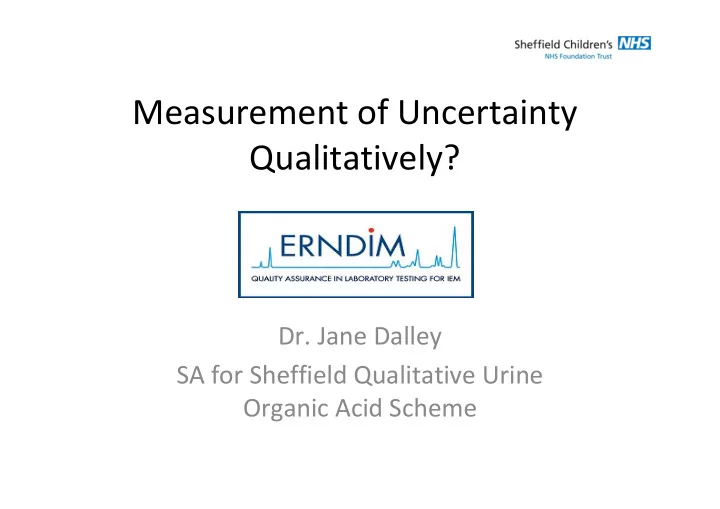

Measurement of Uncertainty Qualitatively? Dr. Jane Dalley SA for Sheffield Qualitative Urine Organic Acid Scheme
What is ERNDIM - • Formed in 1991 “ E uropean R esearch N etwork for evaluation and improvement of screening, diagnosis and treatment of I nherited D isorders of M etabolism” • http://www.erndim.org/home/about.asp
The Schemes
Quantitative schemes • Amino Acids • Quantitative Organic Acids • Urine Special Assays • Urine Purines & Pyrimidines • Special Assays in Serum • Cystine in White Blood Cells • Lysosomal Enzymes
Annual Report • Accuracy • Precision • Recovery • Linearity …… measurement of uncertainty
Qualitative Schemes • Proficiency schemes (Sheffield, Basal, Prague, Lyon, Amsterdam) • Organic acids • DBS acylcarnitines • Congenital Disorders of Glycosylation • Urine Mucopolysaccharides
Qualitatively urinary organic acid scheme • Nine heat treated urine samples per year from real patients with differing metabolic disorders • Participants are asked to • Identify the major analytical findings • Indicate the most likely diagnosis • Suggest any further investigations needed to confirm or clarify the diagnosis • chromatograms
ERNDIM Organic Acid QA Response Form - Laboratory # Sample 230 10 year old boy with myopathy and developmental delay
Scoring • Scoring • Satisfactory 4 • Helpful but incomplete 3 • Not helpful 2 • Slightly misleading 1 • Misleading 0 • Total annual achievable 36 � Proficiency score � sarisfactory performance 22/36 or 15 � Critical error
Lab Number No of returns in Total score 2015 Number of Total score Number of Total score 2013 Total score 2015 out of 36 for 3 returns 2014 2014 returns 2013 out of 36 for 3 returns returns out of 36 for 3 Over 3 years*. returns 82 3 3 3 36 103 34 33 83 2 3 3 34 69 20 15 84 3 3 3 36 108 36 36 85 1 3 3 32 66 10 24 86 3 - - - - 26 - 87 2 - - - - 20 - 88 3 3 - - - 36 24 89 3 - - - - 36 - 90 3 3 3 36 104 32 36 91 3 3 3 30 96 28 38 92 3 3 3 31 91 31 29 93 2 - - - - 22 - 94 3 3 3 36 102 32 34 95 3 3 - - - 36 34 96 3 3 3 32 93 29 32 97 3 3 2 20 91 35 36 - - 98 2 - - 22 - - - 99 3 3 - 36 36 - - 100 3 3 - 30 32 - - 101 3 3 - 28 36 - - 102 3 - 24 - - - - 103 2 - 24 - - - - 104 3 - 36 - -
Participant's 2016 =107 2015 2014 2013 2012 2011 2010 2009 Argentina 3 3 2 2 2 2 2 Australia 6 6 6 6 6 6 6 Belgium 6 6 6 5 5 6 7 Brazil 2 2 2 2 2 - 1 Canada 1 1 1 1 1 1 1 Columbia 1 1 1 1 1 1 1 Chile 1 1 - - - - - Czech Republic - - - - 1 - - Democratic Republic of China 1 1 1 1 2 2 1 Finland 2 2 2 1 1 1 1 France 15 15 15 15 15 13 13 Hong Kong 1 1 - - - - - Germany† 1 1 1 1 1 1 1 Israel 3 3 3 3 3 4 3 Japan 2 2 1 1 1 1 1 Lebanon 1 1 1 1 1 1 1 Malaysia 3 3 3 3 3 4 3 New Zealand 1 1 1 1 1 1 1 People’s Republic of China 9 9 9 8 10 7 7 Portugal 2 2 2 2 2 2 2 Republic of Korea 1 1 1 1 1 1 1 Republic of Ireland 1 1 1 1 1 1 1 Republic of Singapore 1 1 1 1 1 1 1 South Africa 2 2 2 2 2 2 1 Spain 6 6 6 6 6 6 6 Turkey 7 3 3 3 3 3 2 United Kingdom 18 18 18 18 18 19 20 USA 5 5 5 3 3 3 4 Uruguay 1 1 - - - - - Venezuela - - - 1 1 1 1 Vietnam 1 1 1 1 1 - - TOTAL 104 100 94 91 95 90 89
How well do we do?
Diagnosis % Proficiency 95% MMA 86% MCAD (non crisis) 95% Ethylene glycol 88% Fumerate hydratase deficiency 74% SCAD 98% PA 84% MSUD 89% Citrullinaemia 87% 3-methylglutaconic aciduria 96% PKU 95% MCC 100% IVA 79% LPI 82% GA2 98% Malonic acid
Why IMD hard to get right? • They are rare ……. Zebras not horses…. • They are biochemically heterogeneous conditions • They are clinically heterogeneous conditions • Small amounts of key compounds can be important • The analyses are often qualitative rather than quantitative and the interpretation is therefore subjective • Episodic excretion is common (e.g. intermittent MSUD)
Fumarate Hydratase 88% TCA cycle…
Fumarate Hydratase * *
Why IMD hard to get right? • They are rare ……. Zebras not horses…. • They are biochemically heterogeneous conditions • They are clinically heterogeneous conditions • Small amounts of key compounds can be important • The analyses are often qualitative rather than quantitative and the interpretation is therefore subjective • Episodic excretion is common (e.g. intermittent MSUD)
MCAD none crisis sample 86%
* * * *
How to do better and reduce uncertainty? • Participation in EQA scheme's • Training and accreditation • Clinical details • Repeat analysis • Further analysis
Thank you for listening
Recommend
More recommend